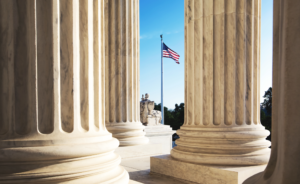This Supreme Court term was filled with surprising unanimous rulings in hot-button cases
In the American Bar Association’s Preview magazine, Pacific Legal Foundation senior legal fellow Elizabeth Slattery authored a piece on the recently concluded Supreme Court term.
In the article, she focuses on two major themes: First, the Court issued a multitude of rulings which were both unanimous and “narrow”; second, that the so-called conservative and liberal Justices often joined together to form odd cross-ideological rulings.
Addressing the “narrow unanimous rulings,” Slattery notes how Chief Justice John Roberts—like many of his predecessor Chief Justices—urges his colleagues to reach unanimous decisions whenever possible. Unanimous rulings from the Roberts Court are typically narrow, often avoiding groundbreaking issues.
Slattery writes:
“Perhaps, though, [Roberts’] fondness for unanimity is motivated less by a desire to increase the law’s certainty and more by a hope to deflect criticism from the media, activists, and politicians and lessen the spotlight on the justices.”
The Justices obviously vary in their political opinions. But imagine a scenario where Justices as politically diverse as Clarence Thomas and Sonia Sotomayor agree on an outcome of a case. Where the Court might otherwise be viewed as partisan and political, a unanimous decision would reduce that perception and the subsequent proposals to reform the judicial system.
Slattery also contends that the decisions are narrow because the court often uses them as “warning shots” before making later, more significant decisions on the subject matter involved in the cases.
She writes:
“Unanimous rulings were decided so narrowly, however, that they likely won’t provide much guidance to lower courts and may simply delay more contentious rulings a few years down the road. Yet, the Roberts Court often takes an initial minimalist approach, followed by a more decisive action.”
Slattery’s next theme is the cross-ideological agreements between “conservative” and “liberal” Justices. In the context of many commentators predicting that the nomination of Amy Coney Barrett to the Supreme Court would produce a more conservative court, Slattery demonstrates that so far, the court has not shifted to the right:
“Other close rulings offered up surprising pairings: Justice Thomas joined by the ‘liberal’ justices; a majority opinion by Justice Barrett that drew dissents from Chief Justice Roberts and Justices Thomas and Alito; and Justice Barrett joined by Justices Sotomayor and Kagan in dissent. Is this evidence of strategic voting or calling balls and strikes?”
She answers her own question by arguing that the cross-ideological rulings may be due to the Court’s increased emphasis on textualism. Some believe that textualism typically produces conservative outcomes, but she points to the Court’s rulings in the last term and suggests that “Textualism is a methodology that doesn’t produce predictable outcomes from a political or partisan perspective, despite what its critics may claim.”
It is difficult to guess what direction the Court will go, as Slattery points out. But she believes the upcoming session may be more tumultuous, with hot-button cases on the horizon.



